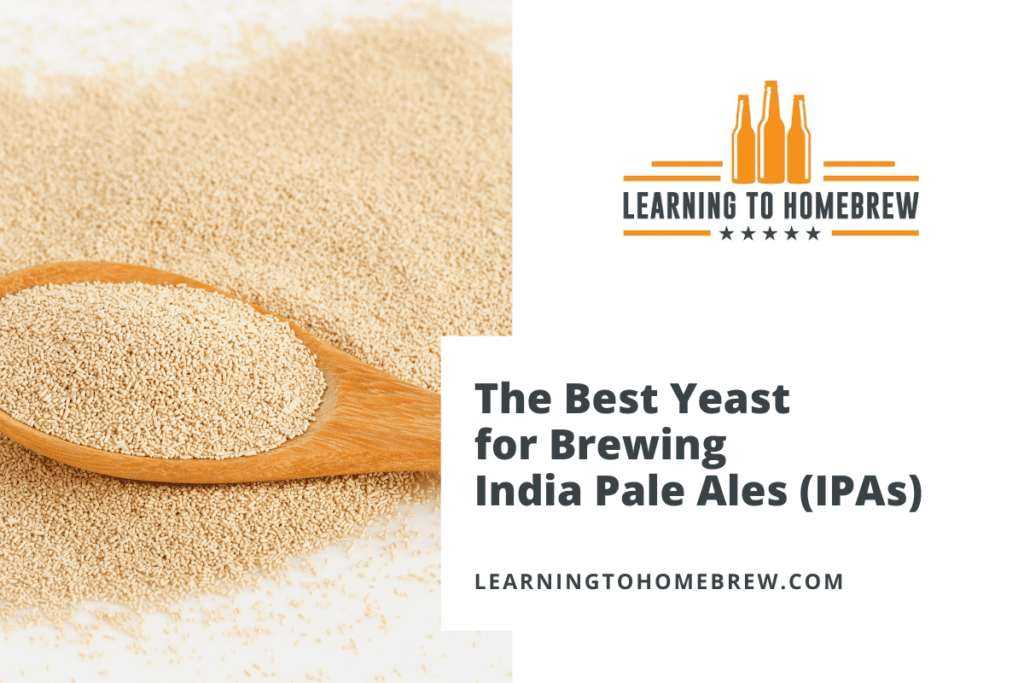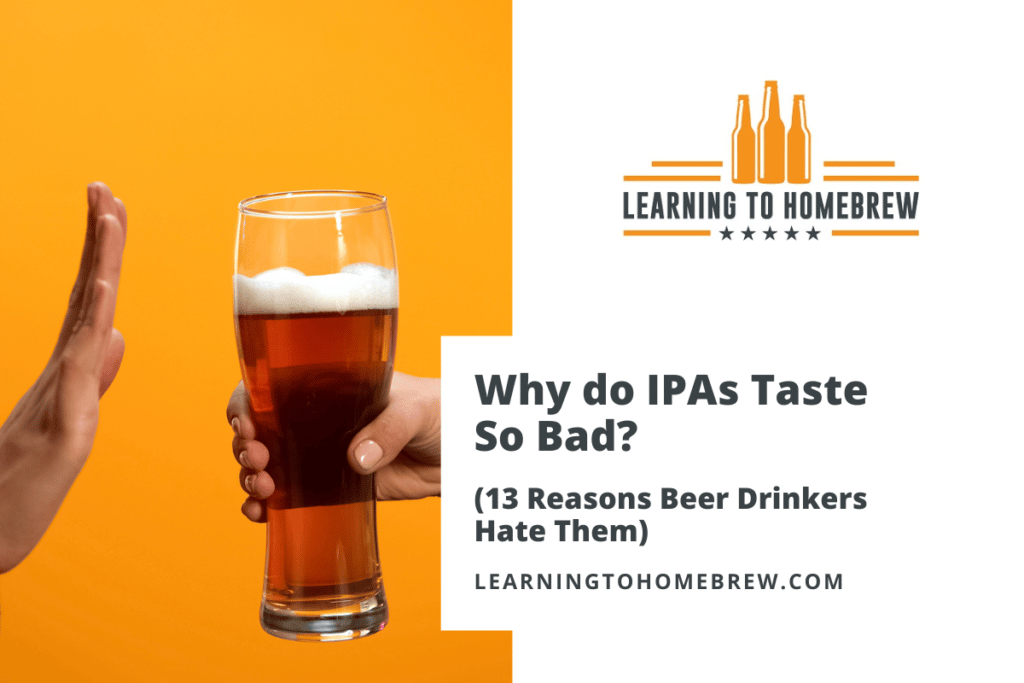India Pale Ales are known for their hoppy and bitter taste and complex aromas. The IPA is an absolute staple for craft breweries, but what makes them so enduringly popular?
Beer drinkers think IPAs taste good because of the beer’s hoppy taste, aroma, and bitterness. The flavors come from the hops used, which also lend the beer bitterness and aroma. Some sub-styles of the IPA, such as the New England IPA and English IPA, are less bitter. Overall, the combination of flavors is what makes IPAs so enjoyable.
Continue reading to find out more about why beer drinkers like IPAs so much. Discover what it is about IPAs that makes them so loved – or, in some cases – so detested.
Topics We Cover
Why do people love IPA so much?
Hops, hops, and more hops – that’s why people love IPAs so much!
The IPA is a hop concoction with malt and yeast playing a secondary role in the taste and aroma of the beer. If you love hops, you’ll love IPAs.
IPAs are hop-forward beers. Hops are the plants used in beer to provide flavor and aroma while also acting as a preservative. Hops offer stone fruit, citrus, tropical and resinous flavors alongside similar aromas. Some IPA styles use hops more for the flavor, while others use them for aroma. Either way, hops are the star of the show.
The IPA is the most popular beer style in the United States for its flavor, aroma, bitterness and even alcohol content.
Flavor
IPAs get their flavor from the hops used. These flavors come from a wide variety of hops and each strain of hops lends a different taste to the beer. Some substyles of IPAs taste hoppier than others.
IPAs are hoppy and bitter. They use hops to balance out the sweetness and to give the style its signature flavor. IPAs use hops to achieve dank, floral, citrus, stone fruit, grapefruit, and many other flavors. Depending on the recipe, they can also taste sweet from the malt used.
The hops used in IPAs affect more than just flavor; they also impact the aroma.
Aroma
An IPA’s aroma comes from the hops used. Partnered with malt, the aroma is overtaken by hop notes.
The aroma of an IPA can be fruity, vegetative, citrusy, tropical, oniony, sulfur-like, or more. These aromatics come from the hops used. Hops that are used late in the boiling part of the brewing process retain their aroma. These scents are carried into the final beer.
The hops used in during the brewing process are responsible for the majority of the beer’s aroma. Malt and yeast also play a role in a beer’s taste and aroma, but this isn’t normally the case in IPAs.
Bitterness
Do IPAs taste bitter? Where does the bitterness come from? It’s all about the hops.
Bitterness is measured in IBUs. Beer IBUs come from the bittering agents generated from hops during the boiling step of the brewing process. Because IPAs use so many hops in their recipes, they’re inherently bitter. Bitterness plays a role in taste. Some people can tolerate more bitterness than others which could be the reason IPAs taste so good.
Certain IPA styles are more bitter than others because of recipe and style differences.
Alcohol Content
IPAs are usually higher in alcohol content than ‘regular beers’ – about 6.3-7.5% ABV to be exact.
The alcohol in beer comes from the malt. Malt sugars are fermented into alcohol during the fermentation process. Generally, although not always the case, more malt in the recipe can produce more alcohol. Hops are used in IPA to balance the alcohol content and malt profile.
Session IPAs are a substyle of IPA that contains less alcohol and emphasizes drinkability.
What makes an IPA taste like an IPA?
Why do IPAs taste so good, and what makes them taste the way they do? The answer is fairly simple: hops.
Hops are the backbone of the IPA beer style. They provide flavor, aroma, and bitterness that are characteristic of the style. Hop profiles are balanced by malt additions and the strain of yeast used. The yeast strain used is contingent on the sub-style of IPA and can lend fruity or neutral flavors. Brewing water also affects the profile of the beer.
Many things impact the flavor of an IPA, but the taste is mostly reliant on the hop varieties used. Different hop varieties are used for different reasons depending on the sub-style of IPA.
Hops
The signature flavor ingredient of the IPA is hops. Hops are added at different times of the boiling part of the brewing process to impart either bitterness or aroma.
Hops are used to provide bitterness and aroma to IPAs. Hops added at the beginning of the boil impart bitterness to the beer through isomerization. Hops added at either the end of the boil or through dry-hopping are added for aromatics.
Bittering
Bittering agents known as alpha acids are found in hops and are used to give IPAs a bitter taste.
The bitterness in IPAs comes from the hops used. Alpha acids from hops are formed during the boiling process. The alpha acids stay in the beer and produce a bitter taste.
Hops that are boiled longer produce more alpha acids and some hop varieties contain more alpha acids than others.
Flavor
Hops offer many different flavors to IPAs.
IPAs are generally classified as hoppy and bitter. The hop profile determines the majority of the beer’s taste. Flavors notes of IPAs come from the hop varieties used during brewing and include stone fruit, grapefruit, citrus, tropical, sulfur, resin, pine, and many others.
Aroma
An IPA’s aroma comes from a mixture of the hops, malt, and yeast used.
Aroma depends on the ingredients as well as the style, but most of an IPA’s aroma still comes from the hops.
American IPA aromas are more resinous or piney. New England IPA aromas are tropical, citrus, and fruity, commonly from dry-hopping.
Dry hopping
Dry hopping is a technique used in brewing to impart potent hop aromas to beer.
IPAs are dry-hopped to improve and enhance the hop aroma of the beer. Once primary fermentation is completed, hops are added back into the beer to steep through a process called dry-hopping.
Yeast
Yeast is used to produce alcohol in beer. Additionally, yeast plays a role in the flavor and aroma of beer.
American IPAs use a neutral yeast strain, one that does not offer any esters and lets the hop profile of the beer shine through. New England and English IPAs can get away with using a yeast strain that yields fruity esters.
Read this article for more about the best yeast to use when brewing an IPA
Malt
Malt doesn’t have much presence in the IPA and typically serves to balance the other flavor notes.
In IPAs, malt does not offer a lot of flavors. Malt plays more of a role in the flavor of English IPAs where hops are only part of the profile. Malt is mostly used to balance the hops notes of American and New England IPAs.
Brewing water
Even the brewing water chemistry impacts the outcome of the beer.
The pH, chloride, and sulfate levels all impact the profile of an IPA. Too high of a chloride level could implement undesired sweet and fruity notes in an American IPA, but these levels would benefit a New England IPA. A higher sulfate content is recommended for American IPAs.
For a comprehensive outline of the best water profile for IPAs, check out this article on the topic.
Does everyone like IPAs?
Is the IPA for everyone? Some beer drinkers enjoy the hop flavors and aroma, and can’t get enough of them, but others detest them.
Admittedly, IPAs aren’t for everyone. It’s assumed that the two main reasons people dislike IPAs are the hoppiness and bitterness associated with the beer style. Some people have a higher tolerance for bitterness, making the IPA more bearable.
Don’t like IPAs? Check out this article for 13 reasons why this style might not be for you.
Although IPAs are disliked by some, they’re loved by many. The IPA is the most-entered beer style in the Great American Beer Festival since 2001, and you can find one on almost any American craft brewery’s tap list at any given time.
The obsession with IPAs isn’t new, and it’s likely here to stay. With the introduction of more sub-styles, IPAs continue to make waves in the industry. From hop-heads to domestic macro beer lovers, there’s an IPA out there for anyone.





